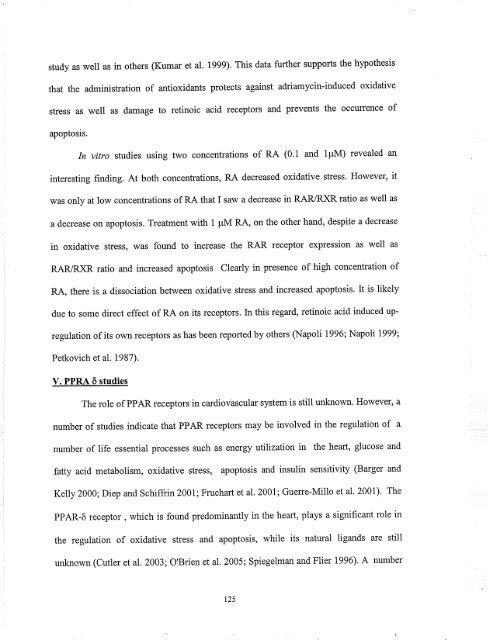il\VOLVEMENT OF RETII\OIC ACID II{ - MSpace at the University of ...
il\VOLVEMENT OF RETII\OIC ACID II{ - MSpace at the University of ...
il\VOLVEMENT OF RETII\OIC ACID II{ - MSpace at the University of ...
Create successful ePaper yourself
Turn your PDF publications into a flip-book with our unique Google optimized e-Paper software.
study as well as in o<strong>the</strong>rs (Kumar et aI. 1999). This d<strong>at</strong>a fur<strong>the</strong>r supports <strong>the</strong> hypo<strong>the</strong>sis<br />
th<strong>at</strong> <strong>the</strong> administr<strong>at</strong>ion <strong>of</strong> antioxidants protects against adriamycin-induced oxid<strong>at</strong>ive<br />
stress as well as damage to retinoic acid receptors and prevents <strong>the</strong> occurrence <strong>of</strong><br />
apoptosis.<br />
In vitro studies using two concentr<strong>at</strong>ions <strong>of</strong> RA (0.1 and lpM) revealed an<br />
interesting finding. At both concentr<strong>at</strong>ions, RA decreased oxid<strong>at</strong>ive stress. However, it<br />
was only <strong>at</strong> low concentr<strong>at</strong>ions <strong>of</strong> RA th<strong>at</strong> I saw a decrease in RAR/RXR r<strong>at</strong>io as well as<br />
a decrease on apoptosis. Tre<strong>at</strong>ment with 1 pM RA, on <strong>the</strong> o<strong>the</strong>r hand, despite a decrease<br />
in oxid<strong>at</strong>ive stress, was found to increase <strong>the</strong> RAR receptor expression as well as<br />
RAR/RXR r<strong>at</strong>io and increased apoptosis Clearly in presence <strong>of</strong> high concentr<strong>at</strong>ion <strong>of</strong><br />
RA, <strong>the</strong>re is a dissoci<strong>at</strong>ion between oxid<strong>at</strong>ive stress and increased apoptosis. It is likely<br />
due to some direct effect <strong>of</strong> RA on its receptors. kr this regard, retinoic acid induced upregul<strong>at</strong>ion<br />
<strong>of</strong> its own receptors as has been reported by o<strong>the</strong>rs (Napoli 1996; Napoli 1999;<br />
Petkovich et al. 1987).<br />
V. PPRA ô studies<br />
The role <strong>of</strong> PPAR receptors in cardiovâscular system is still unknown. However, a<br />
number <strong>of</strong> studies indic<strong>at</strong>e th<strong>at</strong> PPAR receptors may be involved in <strong>the</strong> regul<strong>at</strong>ion <strong>of</strong> a<br />
number <strong>of</strong> life essential processes such as energy utiliz<strong>at</strong>ion in <strong>the</strong> heart, glucose and<br />
f<strong>at</strong>ty acid metabolism, oxid<strong>at</strong>ive stress, apoptosis and insulin sensitivify (Barger and<br />
Kelly 2000; Diep and Schiffrin Z}}L;Fruchart et al. 2001; Guerre-Millo et al. 2001)' The<br />
PPAR-ô receptor , which is found predominantly in <strong>the</strong> heart, plays a significant role in<br />
<strong>the</strong> regul<strong>at</strong>ion <strong>of</strong> oxid<strong>at</strong>ive stress and apoptosis, while its n<strong>at</strong>ural ligands are still<br />
unknown (Cutler et al.2003; O'Brien et al.2005; Spiegelman and Flier 1996)' A number<br />
125







![an unusual bacterial isolate from in partial fulf]lment for the ... - MSpace](https://img.yumpu.com/21942008/1/190x245/an-unusual-bacterial-isolate-from-in-partial-fulflment-for-the-mspace.jpg?quality=85)





![in partial fulfil]ment of the - MSpace - University of Manitoba](https://img.yumpu.com/21941988/1/190x245/in-partial-fulfilment-of-the-mspace-university-of-manitoba.jpg?quality=85)


